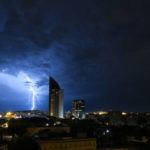As a child, photographer Thomas P. Peschak used to dream about the ocean—about sharks and sea turtles and reefs teeming with colorful fish and other interesting aquatic creatures. As he grew older and became a marine biologist, however, Peschak learned a terrible truth: as a result of overfishing and pollution, the ocean is no longer teeming with life except in small, isolated pockets.
The following video documents Peschak’s amazing experiences as he photographs two of these remote ocean ecosystems on assignment for National Geographic:
An atoll is a ring-shaped island that surrounds an inner lagoon; atolls are composed almost entirely of coral reef and house huge numbers of sea creatures in their private ecosystems. Located in the middle of the Indian Ocean’s Mozambique Channel, the two atolls featured in the video are called Bassas da India and Europa. Peschak calls them “holy grail” atolls because they have been protected from human destruction and may well represent some of the only examples of how life was hundreds of years ago in the ocean’s prime.
The Europa atoll is a sort of “mangrove paradise” where the trees’ tangled roots shelter a wide variety of sea creatures within its lagoon, including sharks, fish, and most importantly, green sea turtles. Since Europa is probably the most important mating and nursery area for green sea turtles in the Indian Ocean, Peschak’s assignment was to photograph them. However, he found them to be particularly elusive.
“Photographing [the turtles] was a lesson in patience and persistence,” Peschak said. “Spotting turtles at the surface is easy, but getting close to them underwater is a different story. There was only one mating pair out of about a hundred that allowed me to get close enough to get the shots I needed.”

Europa is the most primary breeding and nesting ground for green sea turtles in the Indian Ocean.
Photographing the Bassas Da India atoll, which is younger than Europa, boasts no beaches or mangroves, and disappears almost entirely at high tide, was a remarkably different experience for Peschak. He describes Bassas as an “intimidating” place for its “isolated vastness and lack of dry land.” However, most visitors would consider Bassas intimidating because of the sheer number of sharks that patrol its waters.
“If Europa is the kingdom of the turtle, then Bassas Da India is the realm of the shark,” said Peschak. “I had a hunch that the sharks I saw during the day were only a fraction of what was there, so I returned at night to photograph them in their true abundance.”
Using only a studio light rigged to his boat near the water’s surface, Peschak swam among at least thirty mature sharks in the darkness, with sharks “following” him and “waltzing in and out of the light” all around him.

Peschak dubs the Bassas atoll as “the realm of the shark.”
Undaunted by the unknowns of the black, open sea and the sharks brushing past him, Peschak captured a number of stunning images during his nighttime dive at Bassas, and his images were published alongside National Geographic’s April 2014 article about the expedition, which is ironically titled, “A Tale of Two Atolls.”
“It’s moments like these that remind me why I chose this path,” Peschak said. “My work is about literally bringing images to the surface so anyone can see them… photographing the marine realms of these two atolls was like traveling back in time and was a journey I will never forget.”
Like This Article?
Don't Miss The Next One!
Join over 100,000 photographers of all experience levels who receive our free photography tips and articles to stay current:






Leave a Reply